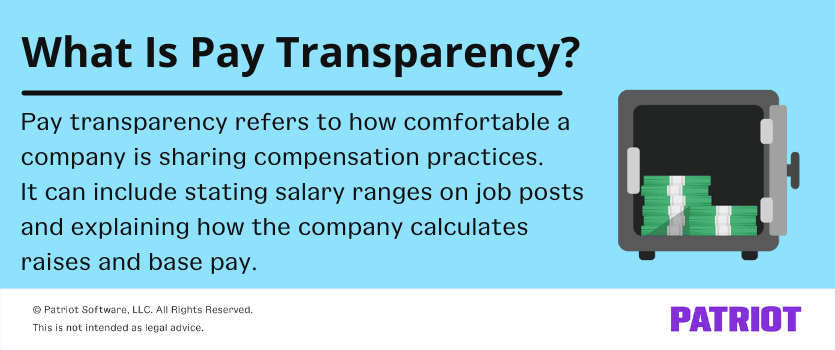What’s the biggest thing a new job applicant wants to know about the job they’re applying for? You guessed it: Applicants want to know how much the job pays. Generally, employers don’t have to share salary information with job applicants. But pay transparency in the workplace is changing across the country. A growing number of states and cities now require employers to disclose salary ranges on job postings or upon request. Read on for the scoop about wage transparency and job seekers.

What is pay transparency?
Pay transparency is part of a movement toward greater pay equity in the workplace. Pay equity happens when employees earn the same amount of money for similar job duties, regardless of their identity (e.g., gender, race, ethnicity, etc.).
There are several federal pay equity laws already in place, including the:
- Equal Pay Act
- Civil Rights Act
- Age Discrimination in Employment Act (ADEA)
- Americans with Disability Act (ADA)
Generally, pay transparency refers to how open employers are about sharing how they compensate employees for their work. The term can cover many different types of information regarding employee pay, such as how:
- Employee compensation works within the company
- Much employees are compensated for specific jobs (within the company and for new hires)
- Raises are calculated
Pay transparency and job seekers
When it comes to hiring new employees, pay transparency describes how easy it is to find the pay range of a particular position. Without salary transparency, job seekers may have no idea how much a job pays until they are well into the hiring process.
Pay transparency and salary range
Job postings are often a black box to job seekers. While applicants may learn of the role and what it requires, they often have no idea what the job pays until they receive a job offer. In these situations, applicants have to apply, get an interview, ask the hiring manager about the pay range and hope that the answer is honest and up-to-date.
Pay transparency doesn’t just affect job seekers. Sometimes employees don’t know the pay scale of jobs in the company they already work for.
Pay transparency legislation seeks to change both practices so that pay scale information is available to job seekers and employees.
Recently, pay transparency laws have caught on across the country. Take a look at this list of pay transparency states and cities around the country:
- California
- Colorado
- Connecticut
- Maryland
- Nevada
- New Jersey (only in Jersey City)
- New York (and New York City)
- Ohio (only in the cities of Toledo and Cincinnati)
- Rhode Island
- Washington
Pay transparency and remote workers
Remote work can complicate pay transparency. Employers have to follow state pay transparency laws if:
- Their business operates in a state with pay transparency laws
- They hire an employee in a state with pay transparency laws, even if the company’s state doesn’t have any laws
Laws in Colorado and New York City are great examples of what this looks like in action.
Colorado has a relatively strict transparency law that is decidedly pro-employee. What does this mean? If a company based outside of Colorado hires a single employee that lives in Colorado (e.g., a remote employee), that company must post pay ranges for any job advertised whether it is in or out of the state. And the same goes for when a Colorado employer seeks to hire someone outside of the state—that company must also post pay ranges for those jobs.
New York City has a similar law on the books. If there is any possibility that the job could go to someone living in New York City, the job poster must include the pay range for the position. This goes for any company, regardless of their location, as long as there is a remote individual in New York City who can perform the job.
Pro tip: To get around these complications, many job posters make it clear where they will and won’t accept applications from.
Pros and cons of pay transparency
Pay transparency seeks to balance the power between employers and employees when it comes to wages in the workplace. But before you jump into the fray, it may be good to consider some of the pros and cons of pay transparency.
Pros of pay transparency
It’s true that pay transparency puts some of the power around wages and hiring tactics into the hands of employees and job seekers. But, there’s more to pay transparency. Pay transparency can help:
- Close pay gaps between your employees
- Build trust with your employees
- Retain employees
- Attract top talent
- Protect you from lawsuits around pay inequity
If you publicly commit to pay transparency but nothing changes or if things change too slowly, your employees might start looking elsewhere for employment.
Cons of pay transparency
Salary transparency isn’t always easy, especially if you’re trying to make the transition to a new system. Here are some of the disadvantages you should consider:
- Employees may be upset about inequitable pay practices from the past
- If you don’t work to fill pay gaps when they become public, that may cause tension across the company
- Job seekers may be reluctant to apply for open positions because they can see how much the position pays and may look elsewhere for higher wages
- Pay transparency won’t immediately create pay equity
- Filling pay gaps isn’t cheap
Creating a pay transparency policy for your business
Whether or not you’re completely on board with pay transparency, it may be a smart decision to draft up a policy now. Who knows? Your state or city government could pass pay transparency legislation when you least expect it. And, it’s always better to be prepared than surprised.
Here are four steps to help you introduce wage transparency to your business.
1. Research your current practices around wages
You may already have a good understanding of how your company pays employees. But pay inequity may be news to you, too. Take a look at your company’s habits around salary, pay raises, and hiring. Before you start, conduct a pay equity survey to know exactly what you’re dealing with.
Here are a few questions you can ask to stay on track:
- When hiring, does the company hire the cheapest employee or adequately pay the most qualified?
- Is there salary information that the company doesn’t want employees to know about?
- Do hiring managers allow job applicants to negotiate for better salaries?
- Are bonus and raise policies clear, fair, and implemented consistently?
- What factors are considered when setting employee pay (e.g., education, time spent in similar roles, previous employers)?
These aren’t the only questions you should ask, but they’ll help you get started creating salary transparency at your business.
2. Define how compensation works
Employee compensation isn’t always easy to understand. Once you start looking into the habits of your company, you may be surprised that employees with the same qualifications are paid different amounts. Now’s the time to define how future compensation will work at your business.
Here are a few questions to consider:
- How do education and years of experience impact employee compensation?
- Should wage negotiations be allowed during the hiring process?
- What are the practices for the rest of your industry?
- Are job titles and compensation ranges consistent across the company?
3. Fill pay gaps
Filling pay gaps across your company is easier said than done. Depending on the differences in pay, this can cost a large amount of money and take some time.
Here are some questions to ask yourself:
- Where are the pay gaps? Are they limited to particular departments or job categories?
- Do the pay gaps stem from base pay, bonuses, or both?
- Do some hiring managers allow applicants to negotiate their base pay while others don’t?
- What’s possible with your budget? Can you fill the pay gaps all at once, or do you need more time?
Once you start the pay transparency process, remember to communicate with your employees as much as possible. Clear and timely communication can help build trust in the process.
4. Create a clear policy to inform your employees of the changes
When first starting out creating pay transparency at your business, there are a lot of things you can do to make the process as smooth as possible. Make sure to write a clear policy to let your employees know of the changes. Keep in mind that your new policy will influence hiring committees, job postings, and interview practices.
Let your HR staff and managers know of changes and plan accordingly. Remember to change any job postings that went up before you made the shift to pay transparency.
Patriot Software makes keeping track of employee wages easier than ever. Patriot’s online payroll software offers unlimited payrolls and free USA-based support. And if you decide pay transparency is right for your business, Patriot has all of the payroll reports you’ll need to understand employee wages. Try it for free today!
This is not intended as legal advice; for more information, please click here.



